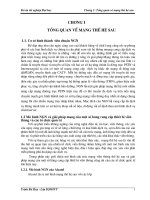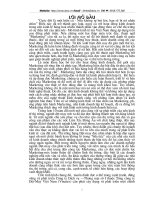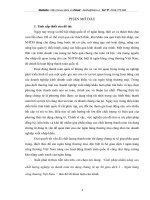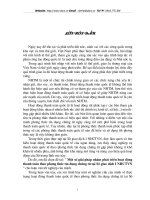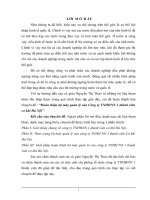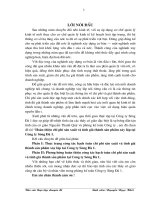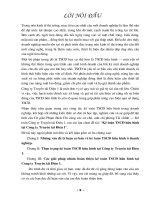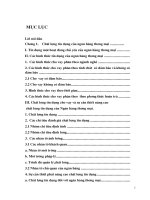19125516-NguyenThiNgocHuyen-Assingment 1
Bạn đang xem bản rút gọn của tài liệu. Xem và tải ngay bản đầy đủ của tài liệu tại đây (83.68 KB, 4 trang )
Name: Nguyen Thi Ngoc Huyen
ID: 19125516
1. Describe a bacterium, a fungus, a protozoan and a virus. Your answer
should be sufficient that another person could learn from you.
* Bacteria: Bacteria are single-celled organisms that can be found almost
anywhere: on your hands, in the ocean, and in your stomach. The bacteria’s cell
type is prokaryotic. It don’t have nuclear envelope and membrane- enclosed
organelles. It has peptidoglycan in cell wall.
* Fungus: Fungi are eukaryotic organisms. Spores are responsible for
reproduction. Glycogen is the major carbohydrate storage product of fungus.
Chitin makes up the cell wall.
* Protozoan: A parasitic single-celled organism that can only divide inside its
host. They havemany different shapes and sizes They can be found in a range of
wet locations, such as fresh water, marine environments, and the soil.
* Virus: A virus is a small infectious agent (20 to 300 nanometers in diameter),
that replicates only within an organism's live cells. Viruses belong to a different
taxonomic group than plants, animals, or prokaryotic bacteria. A virus is made up
of a core of genetic information, either DNA or RNA, that is wrapped by a
protein-based protective covering called a capsid.
2. Provide one example of each microbe listed above and describe how that
microbe replicates.
- Bacteria: Clostridium botulinum reproduces by binary fission, which is a type
of asexual reproduction.
- Fungus: Mucormycosis is a deadly invasive fungal infection that causes
significant mortality rates. Mucormycosis is caused by solitary cells that multiply
through budding.
- Protozoan: Paramecia reproduce asexually through binary fission and reproduce
sexually.
- Virus: Rotavirus replicates in the host cell's cytoplasm.
3. For bacteria, describe the two major groups of bacteria based on their
cell envelope structure (Gram positive versus Gram negative).
- Gram positive bacteria have a strong peptidoglycan cell wall and a plasma
membrane.
- Gram negative bacteria have peptidoglycan cell walls, plasma membranes, and
outer membranes. Lipopolysaccharides, as well as phospholipids and other
proteins, make up the outer membrane.
4. What is a naked virus and how does it compare to an enveloped virus?
- Naked virus (non-enveloped virus) is the virus that lack a lipid membrane
around the capsid
- Compare to an enveloped virus
Naked virus
lack a lipid membrane around the
capsid
No have lipid bilayer with protein
Resistant to heat or acid
More toxic
Example: norovirus, Hepatitis A virus,
Poliovirus…
Enveloped virus
Enclosed within a lipid membrane
around the capsid
Have lipid bilayer with protein
Sensitive with heat or acid
Less toxic
Example: COVID-19, Influenza…
5. Describe a bacterium that is considered a foodborne pathogen and
describe the illness it causes. Explain how this pathogen might enter the
food chain.
Salmonella
- Salmonella is an anaerobic Gram-negative bacillus. It has flagella.
- Sources of infection: Poultry, Raw meat, Raw milk, Vegetables and fruits
- Salmonella infection is an intestinal infection caused by bacteria called
salmonellosis. Bacterial infections can spread from the intestines into the
bloodstream and elsewhere in the body.
- The symptoms of salmonellosis include diarhea, abdominal pain and cramps,
nausea and vomiting, and fever. Symptoms normally appear 12 to 96 hours after
exposure, however they can appear up to two weeks later. And usually resolve in
5-7 days.
- Salmonella might enter the food chain:
+ Eat and drink: undercooked beef, poutry, or fish, eat raw egg, use raw dairy
products, raw vegetables…
+ Touching the feathers, feces of livestock and poultry without washing hands
thoroughly, salmonella bacteria will be transferred to the food
+ If you put raw and cooked food in the same refrigerator compartment, bacteria
will be transferred from raw food to cooked food
+ handle fresh food on the same cutting board as cooked food and vegetables
6. Describe a virus that is considered a foodborne pathogen and describe the
illness it causes. Explain how this pathogen might enter the food chain.
Norovirus: a single-stranded RNA virus; the surface of the virus is made up of
only one protein, which could aid in the development of a vaccine; also known
as: norwalk-like virus, wintertime vomiting disease
- Source of norovirus infections: shellfish, ready-to-eat food (ice, fruit, salads…),
any meal containing particles from a norovirus patient's feces or vomit
- Symptoms: Nausea, Diarrhea, Heavy vomitin, Stomach cramps
7. Describe three different methods that are used to reduce or eliminate
pathogenic microbes contaminating food.
- Pasteurization: Pasteurization is the process of heating food to a temperature in
short time that kills disease-causing germs while drastically reducing rotting
organisms.
- Heat sterilization is a unit procedure that involves heating foods to a sufficiently
high temperature and for a sufficiently long period of time to kill microbial
- Method of salting: To stop bacteria from growing or dying, use a lot of salt
(NaCl). It can inhibit the growth of some pathogenic bacteria with a salt content
of 4.4 percent. Putrefactive bacilli, Salmonella bacilli, and sporophyte bacillus in
meat can be killed by a salt concentration of 10-15%.
8. What is the process of using microbes to generate edible food products?
Give an example of this microbial process and describe how the microbes
are essential (What do the microbes do to make the food?).
Fermentation is a method for producing edible food products that involves the
employment of bacteria.
In yogurt fermentation, lactic acid bacteria will produce the lactose enzyme. The
galactose sugar is then transformed to glucose. Pyruvic acid is formed after
glucose is transformed. The enzyme tacte dehydrogenase converts pyruvic acid
to lactic acid. When fermenting yogurt, it also creates a lot of beneficial bacteria
for the intestines.
9. Describe COVID 19 and provide questions that you think the general
public need to have answered.
The SARS-CoV-2 virus causes Coronavirus Disease (COVID-19), an infectious
disease. Symptoms can emerge anywhere between 2 and 21 days following
exposure. COVID-19 symptoms vary, however fever, cough, and lethargy are
common in moderate instances. Moderate patients may experience breathing
difficulties or mild pneumonia. Severe cases may result in severe pneumonia,
other organ failure, and death. A person who is infected with COVID-19 may not
show any symptoms and, without realizing it, can spread the virus to others.
COVID-19 can make anyone sick and cause them to get very ill or die at any age.
Since 2020, there have been many variants of the SARS-CoV-2 virus, the most
recent is the omicron variant.
- Question: Is there a more dangerous variant?
10.Describe what you expected to learn in this class if the course had
happened as usual.
If the course had happened as usual, I will be learn everything better. Identify the
distinct characteristics of the primary foodborne pathogens, food spoilage, and
food fermentation bacteria directly. I will get to use the lab more and know more
about how do microorganisms work
